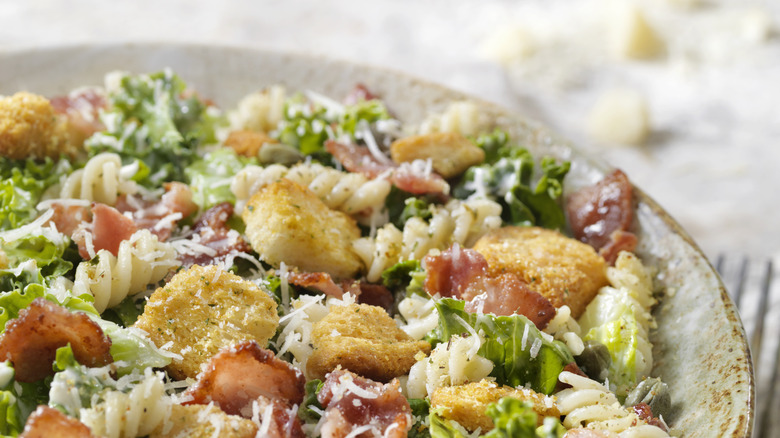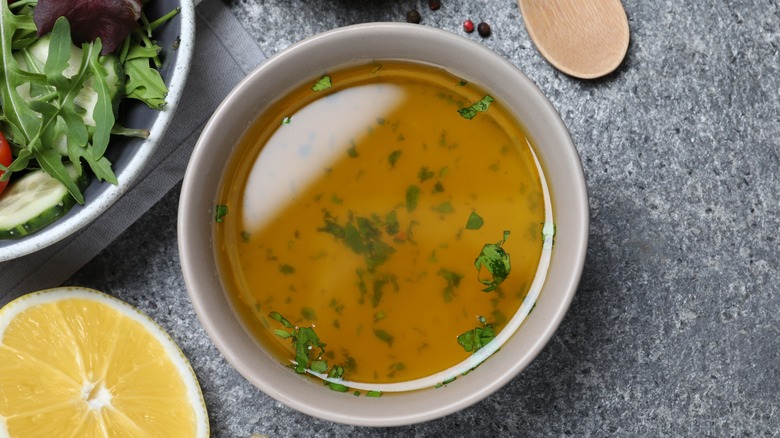For The Perfect Pasta Salad, Play Around With The Oil And Vinegar Ratio
The humble pasta salad is a versatile dish whose ingredients range from the fresh taste of the Mediterranean to the richness of pesto-roasted vegetables. Inside is a mix of layering textures: al dente pasta, crunchy fresh produce, and a silky smooth dressing. But, without a dressing, the pasta salad will be dry, disconnected, and ultimately pretty sad.
The perfect pasta salad dressing amplifies, binds, and interlinks the other ingredients inside the salad, but under no circumstance should it overshadow. A tangy vinaigrette that punches with sharp vinegar may be ideal for a salad containing mild ingredients like lettuce, but for a pasta salad, a lighter touch is needed. Vinegar helps to balance sweet flavors inside the salad; however, a vinegar dressing that's too sharp can leave a lingering bitter or acidic taste throughout the pasta noodles.
On the other hand, a dressing that's heavy on oil risks clouding nuanced flavors developed by the other ingredients in the vinaigrette (such as vinegar or citrus juice). So, measuring the perfect ratio of oil to vinegar will make or break the dressing and, in turn, your pasta salad.
Finding the perfect ratio of oil and vinegar
There are several ways to get the perfect balance with your pasta salad dressing. The first is to use a higher ratio of olive oil than vinegar. This is not uncommon as dressings, such as a French vinaigrette, usually work on a 1:3 ratio of vinegar to oil. However, some more vibrant vinaigrettes work on a much closer ratio of 1:2. It's best to experiment with what you prefer, and if in doubt, perform a taste test on a small section of the pasta salad. If the dressing tastes too bitter, you may consider adding a sprinkle of baking soda to neutralize the skewed sour flavors.
You can also use more citrus juice than vinegar as they both add acidity to a salad dressing. However, lemon juice has a less assertive taste, which means it's simpler to curve those strong sour undertones you'll find in vinegar. When substituting lemon juice for vinegar you'll want to double the measurements i.e. if your dressing calls for 1 tablespoon of vinegar, add 2 tablespoons of lemon juice.
Which oil and vinegar should you use?
You can use many types of oils and vinegar in your pasta salad. However, it's best to use ones that are fit for purpose and will work well with the other salad ingredients. Either a deep red wine or zingy balsamic vinegar work well in an Italian-inspired pasta salad dressing, as the vinegary notes cut through the richness of meat or cheese. A white wine vinegar has a very mellow taste that works with light ingredients where only the slightest hint of vinegar is needed. Apple cider vinegar has fruity, floral notes and is ideal where an extra layer of flavor is required. For example, it would wonderfully burst inside a macaroni salad.
When considering oil, it's ideal to select an oil that's labeled cold-pressed or extra virgin, as these have richer, more complex flavors due to their processing. For instance, the cold-pressed method, used to create extra virgin olive oil, means the oil retains many of its antioxidants and monounsaturated fats, which gives it an assertive flavor. Extra virgin olive oil can range in flavor with earthy grass notes, lighter hints of butter, or sweeter fragrances like apple. Select one that will match the vinegar and other ingredients in your pasta salad.
Making a pasta salad might seem straightforward, but the magic lies within the dressing. Just keep in mind that the correct ratio of vinegar to oil is truly key. You can thank us later.


